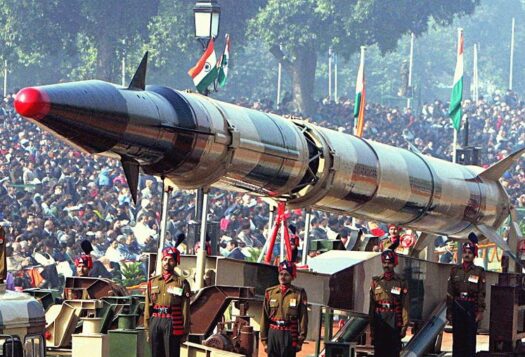
The recent Ladakh military standoff between India and China has drawn significant concern and coverage due to its escalatory nature and the increasingly tense relationship between neighbors. The skirmishes resulted from Beijing’s objection to India’s construction of a road in the Galwan valley, with tensions spiraling into an intense standoff and casualties on both sides. The standoff, which has stretched over a 100-day period, has added to the growing concern in New Delhi about an increasingly militarily aggressive China.
Given the nuclear-armed status of both India and China, there has been buzz around the possibility of nuclear escalation as a result of unresolved territorial disputes. In order to address the nuclear question, it is useful to examine both the relevance of both countries’ deterrence policies to the current scenario and how these policies have played out across previous conflicts between India and China. Both countries have adopted nuclear policies of credible minimum deterrence and No First Use (NFU). Therefore, a change in the aforementioned policies (or lack thereof) coupled with the absence of nuclear signaling and/or escalation in previous conflicts, indicates that a change in future deterrence policies by either country remains unlikely.
Both countries have adopted nuclear policies of credible minimum deterrence and No First Use (NFU). Therefore, a change in the aforementioned policies (or lack thereof) coupled with the absence of nuclear signaling and/or escalation in previous conflicts, indicates that a change in future deterrence policies by either country remains unlikely.
History of the India-China Nuclear Relationship
Post-independence, China’s nuclear weapons program and the 1962 border war were key influences on India’s decision to enhance its own nuclear weapons capabilities. India’s intent to conduct a nuclear weapons test was expedited in order to counter both China’s superior geopolitical position in the region and its successful nuclear test in 1964. When India tested its own nuclear weapons in 1998, it explicitly stated that China was a factor in India developing its program. However, over the years, nuclear deterrence has not played a substantial role in the India-China security relationship.
China’s nuclear weapons were developed as a response to perceived U.S. nuclear blackmail towards China resulting from U.S. policy decisions to deter China’s involvement in the Korean War. China’s significantly more technologically advanced nuclear arsenal (relative to India) indicate it is more focused on force modernization as a factor of the U.S.-China relationship rather than to counter New Delhi’s nuclear program. Limited importance is accorded to the Indian nuclear arsenal, and ambitions in China’s nuclear strategy as the primary focus for Beijing remains on the United States and, to a certain extent, Russia. As China’s nuclear arsenal has remained comparatively much smaller than both the United States’ and Russia’s, it is important to note that China’s program has evolved in order to address the geopolitical implications of nuclear weapons in the post-Cold War era.

Indian and Chinese Perceptions on Nuclear Weapons and Doctrine
In the context of India’s nuclear strategy and threat perception, nuclear deterrence has focused on and intensified both instability and fraught relations with Pakistan. The tensions between the two entered the nuclear realm as recently as February 2019, during the Balakot incident. Traditionally, New Delhi’s nuclear doctrine and force modernization have focused on the perceived threat from Islamabad’s nuclear weapons program. India views Pakistan’s nuclear program as a more immediate security threat than China’s. There have been discussions in New Delhi about the role that nuclear deterrence plays in the fragile relations between the two countries. China’s increasingly aggressive military probes have led to concerns in New Delhi about the efficacy of India’s deterrence posture. As a result, China has factored into India’s deterrence posture to a certain extent with the deployment of INS Arihant as a possible counter to China’s sea-based nuclear deterrent, as well as Agni-V ICBM, the first of its kind capable of hitting any target in China. At present, however, the primary deterrence motivations continue to focus on Pakistan over China.
China’s perception of India’s nuclear capabilities is influenced by the large technological advantage it enjoys in comparison to the latter’s nuclear weapons program. India’s relatively slow nuclear developments have contributed to China discounting the need to respond to India’s nuclear arsenal. Experts believe that China’s perception of its technological superiority suggests that its nuclear arsenal will continue to be directed primarily against the United States and Russia, while India’s comparatively smaller arsenal is unlikely to be factored into Beijing’s strategies. Nonetheless, it is important to note that the increasingly nationalist policies of Xi and Modi have impacted the two state’s economic interdependence and directly challenged this buffer to increasing strategic tensions between the two.
Therefore, it is important to note that both countries, to a large extent, have rejected the notion of possible nuclear escalation between the two at present or in the future. As mentioned, this results from differing perceptions of the role of nuclear weapons in national strategies of both countries towards each other—neither country believes the other requires much attention in terms of nuclear deterrence. Another important factor that points towards the unlikelihood of nuclear escalation as a result of border conflicts between the two are the NFU and credible minimum deterrence policies adopted by India and China. These policies suggest that both India and China see nuclear weapons as a means to safeguard their national security interests rather than as war-fighting instruments. As the term suggests, the NFU position of both countries explicitly states that neither India nor China would use nuclear weapons first in response to conventional conflict. Similarly, the policy of credible minimum deterrence pertains to maintaining a nuclear arsenal solely for assured second strike capabilities and to deter an adversary from attacking. Given the similarity in the role and practice of nuclear deterrence in both India and China, the use of nuclear weapons in a crisis between the two remains unlikely.
Although nuclear escalation is commonly discussed in the case of India-Pakistan conflicts, there is a tendency to reference the possibility of nuclear escalation in the context of Sino-India relations as well. As mentioned, relative nuclear stability between the two coupled with similar doctrines of NFU and credible minimum deterrence emphasizes the implausibility of nuclear escalation. In the recent standoff at Ladakh, observers alluded to the possibility of nuclear escalation because of the deployment of the nuclear-powered INS Arihant, which was part of a larger defense deployment by India. Manpreet Sethi rightly points out that it is normal to move navies out to their operational platforms during a crisis. Therefore, it is unlikely that New Delhi meant this move as a nuclear signal, and India is unlikely to send out an explicit nuclear signal in future scenarios.
Although it would be foolish to suggest that nuclear weapons play no role in the national security and deterrence strategies of India and China, it is important to note that, at present, the priorities in terms of nuclear and deterrence strategy remain different for both India and China and nuclear escalation remains unlikely.
The Future of NFU and the India-China Nuclear Relationship
It would be disingenuous to suggest that there are no instances where doubts have been raised about a possible shift in deterrence strategies away from NFU and credible minimum deterrence and towards a more aggressive force posture by both India and China. Information regarding potential changes in nuclear posture is more readily available for India. For example, in August 2019, India’s Defence Minister Rajnath Singh stated that the future of India’s NFU policy is uncertain. This statement has led many experts and observers to posit that the credibility of India’s NFU policy is in question. Similarly, recent developments in India’s nuclear modernization, as noted by Hans Kristensen and Matt Korda, have placed Beijing in range of ballistic missiles, which suggests that the decision to target China in New Delhi’s strategic plans cannot be entirely ignored.
It is crucial for keen observers to maintain a close eye on such developments and examine their relevance to the future of Sino-Indian border relations. An emphasis, however, needs to placed on the lack of nuclear signaling from either country towards the other in instances of tension or conflicts. These signals are readily observed in other nuclear dyads, such as during conflicts between India and Pakistan. The difference in strategic and nuclear priorities of both countries, coupled with the overarching role of NFU postures, suggests that although nuclear escalation cannot be completely refuted, the likelihood that nuclear relations will tend towards escalation remains improbable.
On August 20th, 2020, India and China agreed to resolve the border standoff expeditiously after a series of diplomatic meetings between the two countries. However, attempts to disengage through diplomatic channels have failed, and tensions continue to escalate at the border. The ongoing incident constitutes an additional skirmish between New Delhi and Beijing that has remained below the nuclear realm. Although it would be foolish to suggest that nuclear weapons play no role in the national security and deterrence strategies of India and China, it is important to note that, at present, the priorities in terms of nuclear and deterrence strategy remain different for both India and China and nuclear escalation remains unlikely. Given the tense relations between the two countries, it is crucial to keenly observe developments in the military, and specifically nuclear, domain. However, it is equally essential to avoid jumping to conclusions of possible nuclear escalation. When it comes to nuclear deterrence, similar nuclear policies of NFU and credible minimum deterrence suggest that India and China’s priorities are unlikely to drastically change in the near future.
***
Image 1: Ashok Boghani via Flickr
Image 2: STR/AFP via Getty Images


